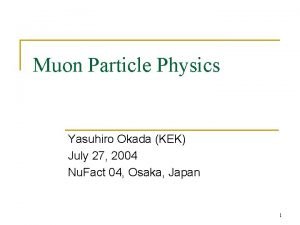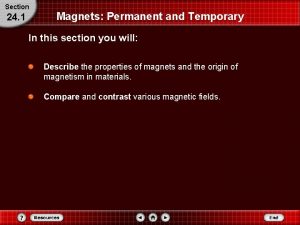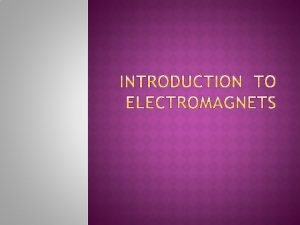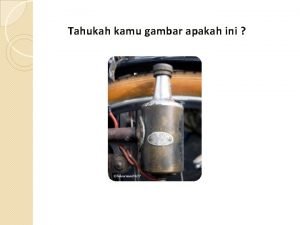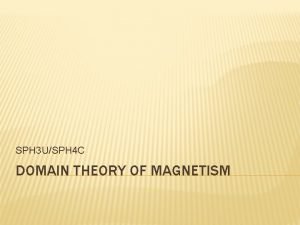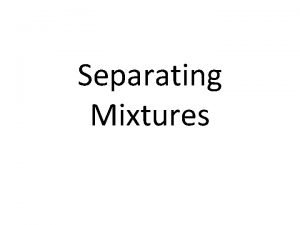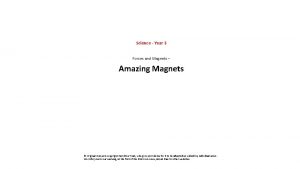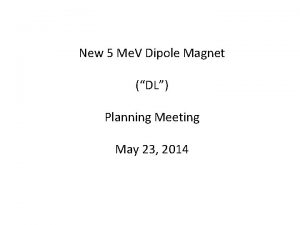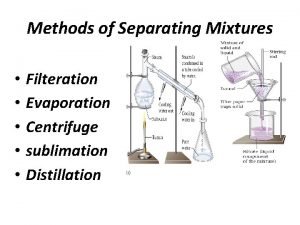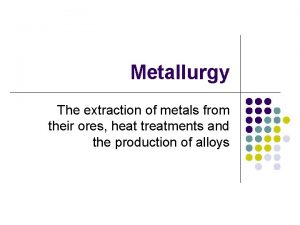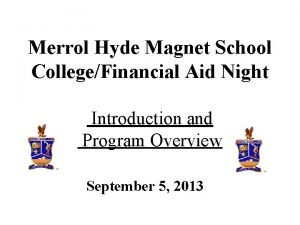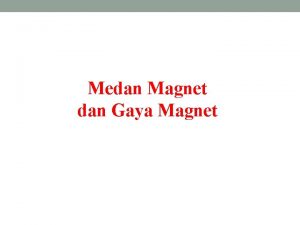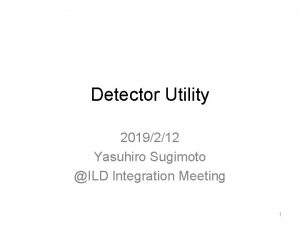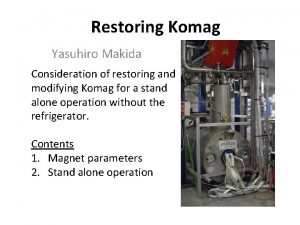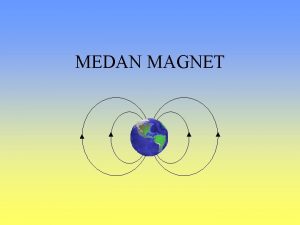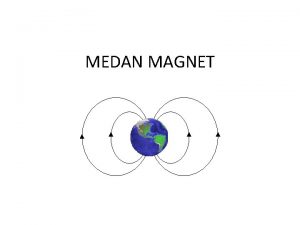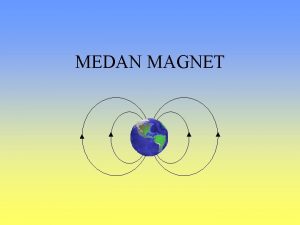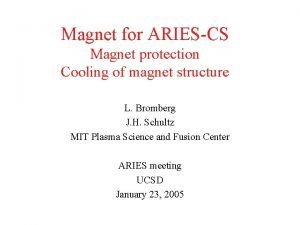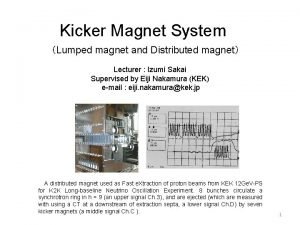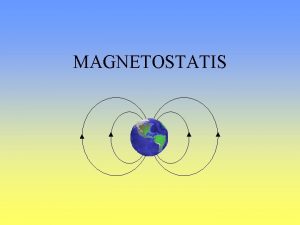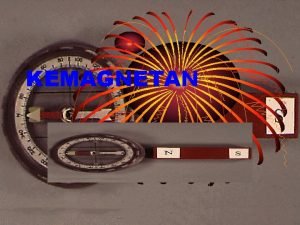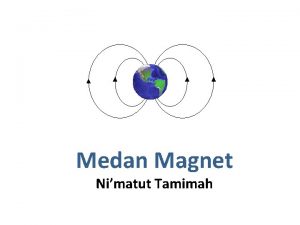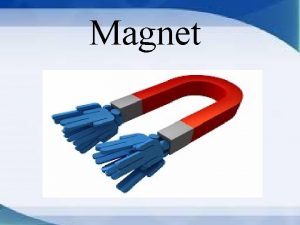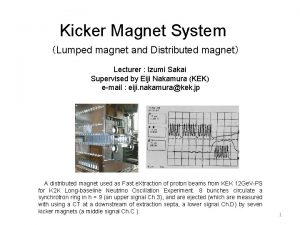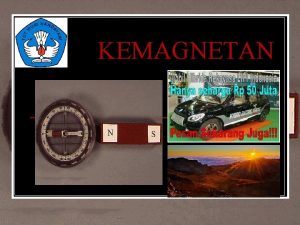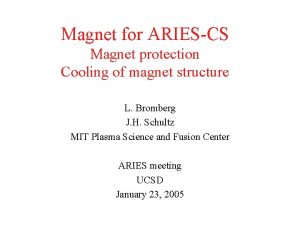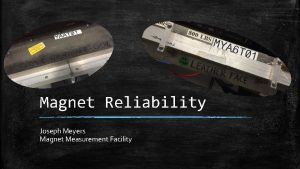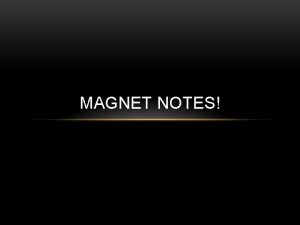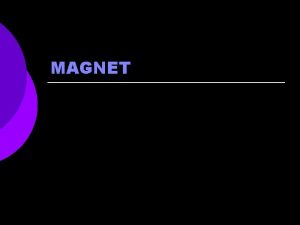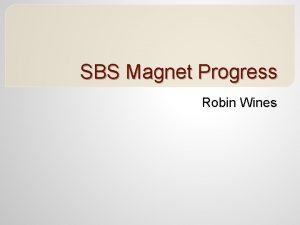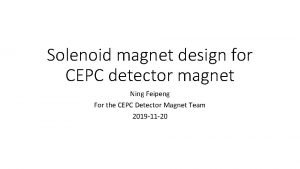Status of Magnet Design Studies 2019212 Yasuhiro Makida




















- Slides: 20

Status of Magnet Design Studies 2019/2/12 Yasuhiro Makida, Takahiro Okamura • Design study about ILD solenoid has been carried out with the cooperation of Hitach and Toshiba. • Recently, a stress analysis due to solenoid coil EMF has been in progress to fix the thickness of an outer shell. • Stress analysis by Hitach shows that stress in the coil with 50 mm thick shell is 105 MPa. • Toshiba is analyzing stress in the solenoid, which has smaller dimensions, because of realistic transportation.

Outline of ILD magnet manufacturing process Anti-DID coils Solenoid Modules From Factory Anti-DID coils From Factory ILD site Presented at Software and technical meeting 2017 -4

Transportation Proposal by Toshiba 1/3 Solenoid Transportation by “JUMBO CARRIER” Each Anti-DID Coil Anti-DID Transportation by low-floor trailer Special permission on public roads. Too slow ? • From view point of transportation from factory to ILC site, solenoid anti-DID size are considered. • Anti-DID is smaller and simpler, which meet the field requirement. • Anti-DID coils are wound in a factory and are set on solenoid in an assembly build on-site.

Coil Dimensions and Solenoid Field TDR & HITACHI TOSHIBA Coil Inner Radius (mm) 3615 3215 Coil Outer Radius (mm) 3970 3570 Length (mm) Each Block Length (mm) 7350 2450 Turn × Layer 309 X 4 300 × 4 (for gap b/w module) 330 × 5 Nominal Current (A) 22400 23072 (in case 300 turn ) 15339 Current Density (A/mm 2) 10. 6 9. 7 Central Field (T) 4. 0 Maximum Field (T) 4. 6 4. 5 Support Shell Thickness (mm) 50 ILD-Small 10 – 100 “Coil (Cryostat)” I. R. (mm) 3075. 33 “Coil (Cryostat)” O. R. (mm) 3825. 33 Yoke I. R. (mm) 4125

Stress Analysis by HITACHI

Field Check with Gap b/w Coil Block by HITACHI with EMSolution Fix n n/2 Turn# n/2 n Turn# n : Reduced axial Turn# in each coil block n = 3, 10 same N I n=3 n = 10

Field Check with Gap b/w Coil Block by HITACHI with EMSolution 107 mm gap @Center Same N・I Same I n

Stress Analysis – Applied Load by HITACHI with EMSolution & ANSYS Field (Br) Map in Coil EMF applied on each Node 1 Node ↔ 1 degree Deg. Shell Thickness 50 mm Deg. Z = 0 (EMF –Stress Analysis Symmetry Plane) Coil Winding Radial Circumferential Axial Young Modulus (GPa) 66. 8 74. 2 62. 6

Stress Analysis – Displacement by HITACHI with EMSolution & ANSYS Displacement Contour Map Radial + Axial Radial Axial Max 2. 2 mm at end of coil to center

Stress Analysis – Stress by HITACHI with EMSolution & ANSYS Displacement Map Stress Contour Map Tresca's yield condition ( σφ-σz<Y ): 60~105 MPa Shearing Stress ( φz plane ) : max 1. 3 MPa Shearing Stress ( φz plane , b/w winding & shell)

Stress Analysis by TOSHIBA

Field and EMF in Coil by TOSHIBA very preliminary Bmax: • Br: 1. 7 T, Bz: 4. 2 T EMF max: • Fr: 47. 5 MN/m^3, Fz: 19. 4 MN/m^3

Stress Analysis by TOSHIBA with Nastran very preliminary Thickness of 90 mm results in a von Mises stress of M 70 MPa Thickness [mm] 10 50 90 150 200 σz [MPa] σθ [MPa] τθr [MPa] τmax [MPa] von Mises [MPa] -22. 54 -19. 79 -20. 2 -20. 42 -20. 37 73. 12 66. 43 61. 01 54. 73 50. 55 40. 6 37. 26 34. 58 31. 47 29. 36 44. 03 39. 62 36. 72 33. 1 30. 61 84. 84 76. 88 70. 51 63. 36 58. 74 Δz [mm] Δφ [mm] Sum [mm] 1. 86 1. 7 1. 58 1. 43 1. 32 3. 64 3. 31 3. 04 2. 72 2. 51 4. 01 3. 55 3. 24 2. 88 2. 65

Coil Dimensions and Solenoid Field TOSHIBA Coil Inner Radius (mm) 3215 Coil Outer Radius (mm) 3570 Length (mm) Each Block Length (mm) 7350 2450 Turn × Layer 330 × 5 Nominal Current (A) 15339 ( will be smaller) Current Density (A/mm 2) 9. 7 Central Field (T) 4. 0 Maximum Field (T) 4. 5 ILD-S Support Shell Thickness (mm) 10 – 100 (now analyzing) “Coil (Cryostat)” I. R. (mm) 3075. 33 “Coil (Cryostat)” O. R. (mm) 3825. 33 “Coil (Cryostat)” Length (mm) 7744

Coil Dimensions and Solenoid Field Z 0 Z 3 Z 1 R 2 Z 2 R 1 BH curve R 0 Solenoid dimensions: R 0 [mm] R 1 [mm] Z 0 [mm] Z 1 [mm] J [A/mm 2] 3215 3570 -3675 9. 7 Iron yoke dimensions: R 0 [mm] R 1 [mm] R 2 [mm] Z 0 [mm] Z 1 [mm] Z 2 [mm] Z 3 [mm] 550 4595 7755 -6620 -4060 6620

Field and EMF in Coil by TOSHIBA Bmax: • Br: 1. 7 T, Bz: 4. 2 T EMF max: • Fr: 47. 5 MN/m^3, Fz: 19. 4 MN/m^3

Stress Analysis by TOSHIBA with Nastran 50 mm Thick Support Shell Case Shear Stress Axial Stress Center Joint Stress Unit Coil Shell Joint Axial MPa -13. 863 -28. 01 -13. 056 Hoop MPa 61. 64 53. 72 55. 51 Shear(Rθ) MPa 1. 837 -9. 63 -0. 631 Shear Max MPa 36. 598 34. 59 30. 965 Von mieses MPa 70. 055 60. 73 60. 688 Von Mises Stress Center Von Mises Stress [MPa] Joint 75. 0 70. 0 最内層 Coil Inner Layer Coil Outer Layer 最外層 65. 0 60. 0 55. 0 0. 0 1000. 0 2000. 0 Z [mm] 3000. 0 4000. 0

Stress Analysis by TOSHIBA with Nastran Shell Thickness vs. Von Mises Stress 64. 0 3 60. 0 Displacement [mm] Hoop stress [MPa] 62. 0 CASE A 58. 0 56. 0 54. 0 0 74 2. 8 2. 7 50 100 150 Thickness [mm] 2. 5 Von Mises Stress [MPa] 72 CASE A 70 68 66 64 62 60 CASE A 2. 9 2. 6 52. 0 50. 0 Displacement 3. 1 Hoop 0 50 100 Thickness [mm] 150 0 20 40 60 Thickness [mm] 80 100 120

EMF b/w Coil and Shell 50 mm Thick Support Shell Case 3000 Z方向 Bonding Force [N] 2500 2000 θ方向 1500 1000 500 0 -500 -1000 -1500 Axial Force 1000 0 1000 2000 3000 4000 Z [mm] Bonding Force Density [MPa] 4. 5 4. 0 3. 5 3. 0 2. 5 2. 0 1. 5 1. 0 0. 5 0. 0 -0. 5 -1. 0 0 Axial stress Z [mm]

Summary & Study Plans • HITACH has analyzed the stress in the coil due to EMF of solenoid. – Maximum stress in the coil with 50 mm thickness support shell is 105 MPa, which is lower than 150 MPa (CMS criteria). • TOSHIBA has been analyzing the stress in the coil, which diameter is smaller. – 800 mm reduction , IR 3215 and Bcenter = 4. 0 T – 70 MPa with 50 mm thickness support shell – Cryostat Design -> ILD small dimensions. • Smaller Al stabilized conductor for realistic manufacture. – Too large 74. 3 X 22. 4 mm 2 (TDR) -> CMS size 50 X 22 mm 2 – 4 layers -> 6 layers, 22. 4 k. A -> 15. 0 k. A – Radial thermal conductivity, quench characteristic.
 Yasuhiro okada
Yasuhiro okada Difference between permanent magnet and temporary magnet
Difference between permanent magnet and temporary magnet Are electromagnets permanent or temporary
Are electromagnets permanent or temporary Apakah magnet berasal dari kata magnesia
Apakah magnet berasal dari kata magnesia Paradigm shift from women studies to gender studies
Paradigm shift from women studies to gender studies Outdoor and environmental studies
Outdoor and environmental studies Legal studies study design 2021
Legal studies study design 2021 Drama study design
Drama study design Westlake magnet
Westlake magnet Tucson high magnet school
Tucson high magnet school Brewbaker technology magnet high school
Brewbaker technology magnet high school Peta konsep tentang magnet
Peta konsep tentang magnet Domains of a magnet
Domains of a magnet Magnetism separating mixtures
Magnetism separating mixtures Amazing magnets fishing magnet
Amazing magnets fishing magnet Magnet dl
Magnet dl Sublimation separating mixtures
Sublimation separating mixtures Magnet seperation
Magnet seperation Merrol hyde magnet school tuition
Merrol hyde magnet school tuition Medan magnetik
Medan magnetik Electric bell bbc bitesize
Electric bell bbc bitesize
